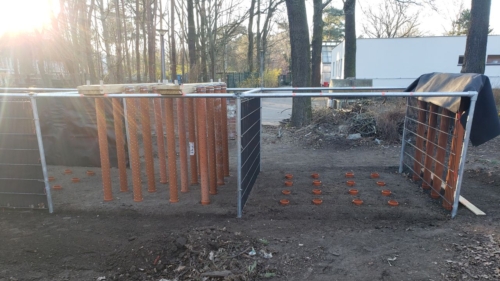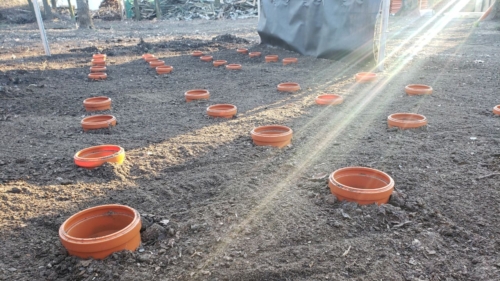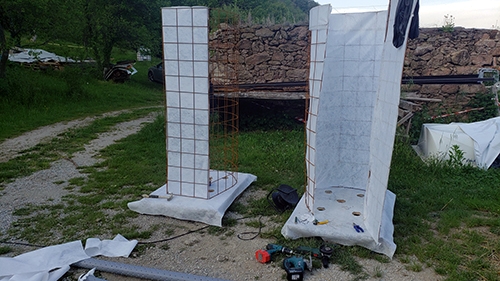Fungal bioreactors
Soils are 3-dimensional spaces consisting of organic and inorganic matter. Geochemical processes within care driven by physical processes and a multitude of organism of different trophic levels, they recycle nutrients and make them plant available. Their choreography is fragile and heavily dependent on key species and diversity – this is disturbed by modern industrial agricultural practices. To restore soil function (nutrient recycling) to increase crop yield and resilience to environmental extremes it’s not only mandatory to reintroduce a biodiverse microbiome but also to change agricultural practices to maintain it.
In the following pages we will introduce a low-tech method to produce a soil inoculant for reintroducing a healthy soil-microbiome to degraded soils. This fungal-dominated composting technology by Johnson and Su et al. is part of the Biologically Enhanced Agricultural Management (BEAM) practices. The idea is to empower communities, farmers, and gardeners to kickstart their soil improving efforts. In the following description we will refer to the original design with a few tweaks from us.
How to build the reactor
Preparations
You can source all materials in local hardware stores or agriculture shops. The wire re-mesh is sometimes hard to find, try metal traders or constructions sites – it is usually used for reinforced concrete.
Material
* Landscape fabric
* Standard pallet
* Wire re-mesh
* PVC Pipe
* Tie wire/garden wire
* Drip irrigation system
* Bamboo/Sticks
* Rubber band
Tools
* Angle grinder/Bolt cutters
* Pliers
* Jig saw
* Scissors/Cutter knife
Position
When setting up to a final position look for a place with minimal sun exposure to reduce water consumption. We chose a build height of 1,80m and a position on a slope for easy filling. If you don’t have a slope keep in mind that you need to fill with a ladder. Without a slope, we recommend to reduce the overall height for more safety and ease of loading.
Assembly
1) Use pipes as guide and draw circle onto palette with marker. Add some millimeter offset for easy sliding. Drill holes into markings and cut with jig saw holes for the pipes.
2) Cut a piece of landscape fabric that fits to the palette and fix with some nails. Cut holes with cutter knife for pipes.
3) Cut wire re-mesh into dimensions. Add landscape fabric and cut to fit while still laying on ground and fix it with wire. Nails are good to poke a hole into the fabric. Then get the wire re-mesh onto the palette and fix with 2 nails crossed.
4) To fix the wire re-mesh add 2 wires and cover with something, so nobody hurts her or himself.
5) Add front door with wires.
6) Fix pipes into position. We had bamboo locally available and used wire to fix them into position.
7) Cut small pieces from leftover landscape fabric and cover pipes. Fix with rubber band.
8) Install micro drip irrigation system.
Operation
The most important thing for the process is to maintain moisture and oxygen supply. The micro drip irrigation system needs to run every day for 1 minute with normal water pressure. During rainy seasons or generally in autumn this frequency can be also reduced according to your experience. Especially the reactor walls are drying out quick, so it’s recommended to position the micro drip irrigation system in a way that they are well moistened. The compost must cure for 12-16 months, a good thorough aggregate structure with particle sizes of smaller than 5 mm are good indicators that it’s ready for use.









Acknowledgements
At the end of 2020, Malte was setting up his first fungal bioreactor in Wuhlheide, Berlin. In cooperation with FEZ-Berlin this reactor was further developed to a scaleable and low-maintenance unit that is optimally integrated into the workflows of the park management. It now turns large quantities of oak leaves into high-quality humus.
During a Soil Research Week that was realized within the framework of “UROŠ - Ubiquitous Rural Open Science Hardware” we then built a smaller bioreactor that was inspired by the design of Johnson and Su et al.
Many thanks to Zavod Rizoma for offering the research location & infrastructure. The UROŠ project has been supported financially as part of the konS ≡ Platform for Contemporary Investigative Arts.
We continue to work on fungal bioreactors and will eventually publish a “Short Guide”-Zine on the topic.